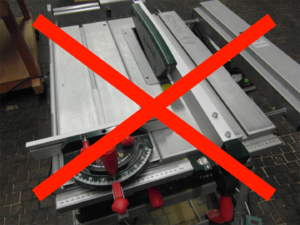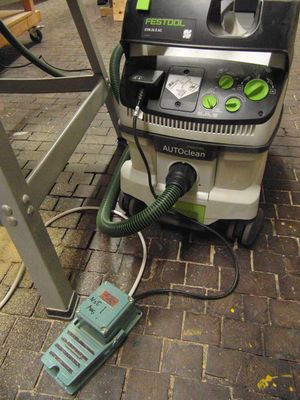Table Saw Introduction
From CoMakingSpace Wiki
This is the content required for an introduction to our table saw - reading this does NOT replace the mandatory session with a tutor! It will make it a lot quicker though ;-)
Let's begin! First off, make sure you have read the machine's manual.
Safety
Dangers
- sawdust and small splinters can fly towards the operator
- sharp and rotating exposed blade - will keep spinning for a bit after turning the power off!
- kickback - if the workpiece is pressed against the blade's side, it can be thrown towards the operator! Check out this video this video on YouTube to see what that looks like.
Precautions

- do not use the table saw when you are alone in the space, you might need another Maker to call help in case of an accident
- wear personal protection
- definitely goggles and ear defenders!
- dust mask: depending on the material you are cutting
- gloves: make an informed decision
- some sources say you should wear them to protect yourself against splinters which could surprise you and make your hand flinch in a dangerous position
- others prohibit the use of gloves as your entire hand could be dragged into the blade if one gets caught
- your hands need to stay well clear (at least a hand's width) of the blade at all times - use a push stick if you have something small to cut!
- height of the blade: make an informed decision
- high blade: cuts "down", not pushing against you - makes the saw easier to use and leads to less of a difference between cut distances on top and bottom BUT it exposes a lot of the dangerous blade
- low blade: lower risk of serious injury (could cut into your finger, not as easily trough it) but you have to push the workpiece harder
- prevent kickback:
- never use both fences at once (option: fence + stop block which ends before the blade begins)
- never remove the splitter and check that it is in line with the saw blade
- make sure the parallel fence is in fact parallel
- do not cut several pieces on top of each other!
- use a shorter parallel fence when cutting solid wood (Massivholz) - that way, there is room for tensions to be released after the cut (second half of the blade should stand "free") [1]
- stand on the side where you can support the main part of your workpiece (usually the left)
- give the saw time to start up before touching the blade with your workpiece!
- make sure all screws (parallel fence, outfeed table) are tightened
Practical Demonstration

- parallel fence: three options depending on the desired distance
- foot switch as the preferred "off" option
- practice cut with miter fence & parallel fence